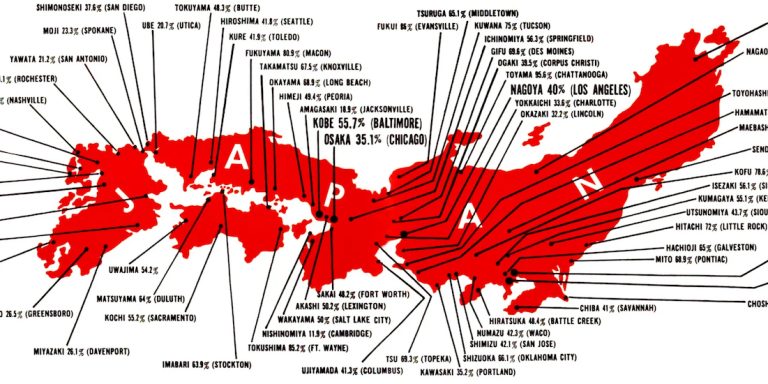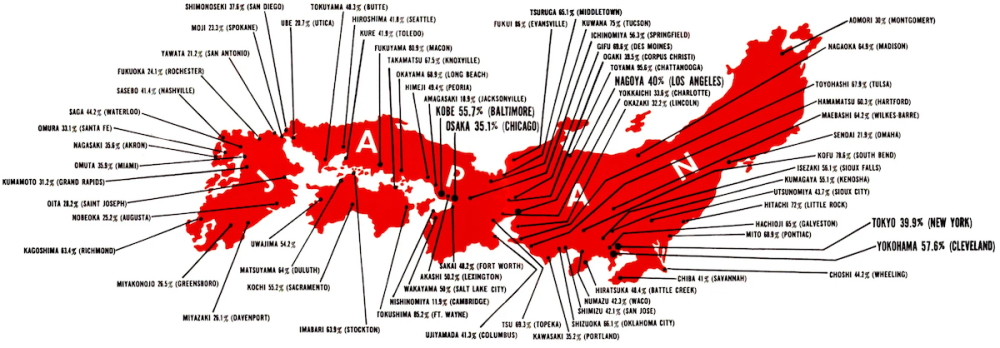
Visualizing the Unimaginable Scale of U.S. Firebombing Campaigns Against Imperial Japan

New York, N.Y. – Imagine a map where the familiar outlines of American cities – Chicago, Los Angeles, Philadelphia, Detroit – are overlaid not with their own streets, but with the charred ruins of their Japanese counterparts. This is the unsettling reality presented by a map produced after World War II by the U.S. Office of War Information.
It serves as a chilling cartographic epitaph for Imperial Japan’s urban landscape, systematically incinerated by the relentless campaign of American B-29 Superfortresses in the war’s final, brutal year.
Eighty years after Emperor Hirohito announced Japan’s surrender on August 15, 1945, following the cataclysmic atomic bombings of Hiroshima and Nagasaki, this map compels us to confront the sheer, almost incomprehensible scale of conventional destruction that preceded those nuclear horrors.
The map’s power lies in its brutal simplicity. It pairs major Japanese cities with U.S. cities of roughly equivalent pre-war population. Lines then demarcate the percentage of each Japanese city reduced to ashes. The effect is visceral.
Seeing the outline of, say, Cleveland, Ohio, with the notation that 99.5% of Toyama, its Japanese counterpart, was destroyed, forces a reckoning. It transforms abstract statistics of ruin – percentages and square miles – into something relatable, a mental superimposition of devastation onto the familiar geography of home.
This was not collateral damage; it was the deliberate, calculated application of aerial bombardment aimed at breaking a nation’s industrial capacity and, critically, its civilian morale through firestorm and terror.
The Strategy of Scorched Earth from the Sky
The path to this near-total urban annihilation began earlier in the war but intensified dramatically under the command of General Curtis LeMay, appointed to lead the XXI Bomber Command in the Mariana Islands in January 1945.
Faced with the limitations and losses of high-altitude precision bombing against Japanese targets – often obscured by cloud cover and buffeted by the jet stream – LeMay instituted a radical and ruthless shift in tactics.
He ordered the B-29s stripped of most defensive armament to increase bomb load capacity. He mandated low-altitude night raids, sometimes as low as 5,000 feet (1,524 meters), flying beneath the jet stream and enemy defenses.
Most devastatingly, he switched the payload from high explosives to clusters of M69 incendiary bomblets, specifically designed to ignite the predominantly wooden architecture of Japanese cities.
The rationale was brutally pragmatic. Japanese war industry was dispersed across countless small workshops and home factories nestled within residential areas. Burning these districts would cripple production and logistics while rendering millions homeless, creating a humanitarian crisis designed to shatter the will to fight.
The first major test of this new strategy came on the night of March 9-10, 1945, against Tokyo. In a single raid, over 300 B-29s dropped approximately 1,665 tons (1,510 metric tons) of incendiaries.
The resulting firestorm, fanned by winds, reached temperatures exceeding 1,800°F (982°C), melting asphalt and creating suffocating cyclones of flame. An estimated 100,000 people died that night, and over 16 square miles (41 square kilometers) of the city – roughly comparable to the area of Manhattan below Central Park – were obliterated. It remains the single deadliest air raid in human history.
A Nation Engulfed in Flame
The Tokyo raid was not an aberration; it was a template. The map tells the tale of what followed in relentless succession.
Nagoya, paired with Los Angeles, saw 89% of its urban area destroyed. Osaka, compared to Chicago, suffered 55% destruction. Kobe, juxtaposed with Philadelphia, was 56% destroyed. Yokohama, aligned with Baltimore, was 58% razed. Smaller cities fared no better. Toyama (Cleveland) was 99.5% destroyed. Fukui (Des Moines) suffered 85% destruction. Sendai (Minneapolis) was 63% gone. Kagoshima (Norfolk) was 76% incinerated. The list goes on, a grim roll call of urban death recorded in percentages on a map designed for American eyes.
The human cost was staggering. Conservative estimates suggest at least
330,000 Japanese civilians were killed in the firebombing campaign, with
another 430,000 injured. Over 8.5 million people were rendered homeless.
The Strategic Bombing Survey later noted that by July 1945, “the great cities of Japan…were in large part only skeletal remains.” Essential services – water, sewage, transportation – collapsed. Disease spread. Food became desperately scarce. The psychological toll was immense, a constant state of terror under the drone of the B-29s and the rain of fire.
While the Japanese military regime, steeped in bushido and State Shintō ideology, vowed resistance to the bitter end, the civilian population endured a hellscape largely invisible to the outside world until the war’s conclusion.
The Atomic Culmination and Lingering Shadows
The firebombing campaign reached its zenith just as the Manhattan Project delivered its apocalyptic fruits. On August 6, 1945, the B-29 Enola Gay dropped “Little Boy” on Hiroshima, instantly killing an estimated 70,000-80,000 people and destroying roughly 70% of the city’s buildings.
Three days later, “Fat Man” exploded over Nagasaki, killing approximately 40,000-75,000 immediately. While uniquely horrifying in their instantaneous, all-encompassing destructive power and lingering radiation effects, the atomic bombs were, in a grim sense, the culmination of the existing strategy of urban annihilation, delivering the devastation of multiple firebombing raids in a single, blinding flash.
The map, notably, includes both Hiroshima and Nagasaki. Hiroshima, paired with Denver, shows 60% destruction – a figure that belies the unique, totalizing nature of the atomic blast in the city center but reflects the overall damage pattern. Nagasaki, paired with Salt Lake City, shows 44% destruction.
Faced with the utter collapse of his nation’s cities, the imminent threat of Soviet invasion following their declaration of war on August 8, and the unprecedented horror of the atomic bombs, Emperor Hirohito made the unprecedented decision to intervene directly.
In his Gyokuon-hōsō (Jewel Voice Broadcast) on August 15, he announced Japan’s acceptance of the Potsdam Declaration, stating the enemy had begun “to employ a new and most cruel bomb, the power of which to do damage is, indeed, incalculable, taking the toll of many innocent lives.” The Pacific War was over.

The Map as Monument and Question
Eighty years later, the OWI map endures as a stark, sobering artifact. It is a monument not to military triumph, but to the terrifying totality of modern industrial warfare waged against civilian populations.
It forces uncomfortable questions: Was the level of destruction necessary to end the war? Did the firebombing campaign, culminating in the atomic bombs, truly save more lives than it cost, as proponents argued? Or did it cross a moral threshold into indiscriminate terror bombing?
The map offers no easy answers, only a visualization of the price paid in bricks, mortar, wood, and flesh.
It stands as a testament to the Tokyo Air Raids, the forgotten holocaust of fire that preceded the atomic age. It reminds us that the scars on the cities – and the survivors, the hibakusha of both conventional and atomic bombing – shaped modern Japan profoundly.
The map, pairing Kōbe with Philadelphia or Ōsaka with Chicago, compels a recognition of shared humanity obscured by the fog of war. It is a silent plea from history, urging remembrance of the ashes upon which the postwar peace was built and a vigilance against the forces that lead nations to unleash such devastation upon one another.
Eighty Years On: Mapping the Ashes of Japan’s Bombed Cities (Aug. 15, 2025)
Summary
Eighty years after Japan’s surrender, a stark U.S. map reveals the near-total destruction of its cities by American firebombing. Juxtaposing Japanese cities with similar-sized U.S. counterparts, it shows the horrific scale: Tokyo 51% gone, Toyama 99.5%. This campaign, killing hundreds of thousands before Hiroshima and Nagasaki, aimed to break Japan. The map forces us to confront the terrifying reality of total war and the ashes upon which peace was built.
#WWII #PacificWar #Firebombing #TokyoAirRaids #Hiroshima #Nagasaki #USJapan
#B29 #MilitaryHistory #NeverAgain #StrategicBombing #WWIIHistory #80thAnniversary
TAGS: World War II, strategic bombing, Curtis LeMay, B-29 Superfortress, Emperor Hirohito,
incendiary bombing, Tokyo Air Raid, Hiroshima bombing, Nagasaki bombing, Pacific War,
U.S. Office of War Information, urban destruction, 20th century history, Japanese surrender
